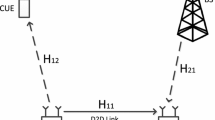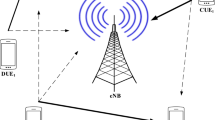Abstract
Device-to-device (D2D) communication has attracted much attention in the field of mobile networks for local area connectivity due to its spectral efficiency, high bit rate support and low power consumption. A group of D2D capable devices, called a cluster, can be connected through multiple links by sharing common resources. This may however result in co-channel interference between them. In this paper, we propose a novel orthogonal precoding vector selection method for reducing co-channel interference and thus maximizing the achievable data rate for each device in the cluster. The proposed method can be employed for uplink and downlink transmissions of both cellular and D2D communications. The analysis of the proposed method is carried out for the case where the cellular channel resource is being shared by single and multiple D2D links. Initially, the results via simulations are compared with the theoretical analysis and the performance of the proposed method is evaluated and compared for different resource sharing modes. The results show that our proposed method enhance the system throughput when compared with the conventional precoding vector allocation method. Finally, the paper illustrates that the introduction of cluster head in a cluster can save battery life of devices.












Similar content being viewed by others
References
Fodor G., Dahlman E., Mildh G., Parkvall S., Reider N., Miklos G., Turanyi Z. (2012) Design aspects of network assisted device-to-device communications. IEEE Commun Mag 50(3):170–177
Mumtaz S, Lundqvist H, Huq KMS, Rodriguez J, Radwan A (2014) Smart direct-LTE communication: an energy saving perspective. Ad Hoc Networks 13(Part B):296–311
Lei L, Zhong Z, Lin C, Shen X (2012) Operator controlled device-to-device communications in LTE-Advanced networks. IEEE Wirel Commun 19(3):96–104
Bae S, Gu J, Hasan S, Chung M (2014) Congestion dispersion in device-to-device discovery for proximity-based services. Ann Telecommun1–13
Doppler K, Rinne M, Wijting C, Ribeiro C, Hugl K (2009) Device-to-Device communication as an underlay to LTE-advanced networks. IEEE Commun Mag 47(12):42–49
Yu C-H, Tirkkonen O, Doppler K, Ribeiro C (2009) Power optimization of device-to-device communication underlaying cellular communication. In: IEEE international conference on communications, ICC, pp 1–5
Cheng Y, Gu Y, Lin X (2013) Combined power control and link selection in device-to-device enabled cellular systems. IET Commun 7(12):1221–1230
Xu X, Wang H, Feng H, Xing C (2015) Analysis of device-to-device communications with exclusion regions underlaying 5G networks. Transactions on Emerging Telecommunications Technologies 26(1):93–101
Min H, Seo W, Lee J, Park S, Hong D (2011) Reliability improvement using receive mode selection in the device-to-device uplink period underlaying cellular networks. IEEE Trans Wirel Commun 10(2):413–418
Li J, Lei M, Gao F (2012) Device-to-device (D2D) communication in MU-MIMO cellular networks. In: IEEE global communications conference (GLOBECOM), pp 3583–3587
Hasan M, Hossain E, Kim DI (2014) Resource allocation under channel uncertainties for relay-aided device-to-device communication underlaying LTE-A cellular networks. IEEE Trans Wirel Commun 13(4):2322–2338
Yu C-H, Doppler K, Ribeiro C, Tirkkonen O (2011) Resource sharing optimization for device-to-device communication underlaying cellular networks. IEEE Trans Wirel Commun 10(8):2752–2763
Wang J, Zhu D, Zhao C, Li J, Lei M (2013) Resource sharing of underlaying device-to-device and uplink cellular communications. IEEE Commun Lett 17(6):1148–1151
Wang H, Chu X (2012) Distance-constrained resource-sharing criteria for device-to-device communications underlaying cellular networks. Electron Lett 48(9):528–530
Min H, Lee J, Park S, Hong D (2011) Capacity enhancement using an interference limited area for device-to-device uplink underlaying cellular networks. IEEE Trans Wirel Commun 10(12):3995–4000
Feng D, Lu L, Yuan-Wu Y, Li G, Feng G, Li S (2013) Device-to-device communications underlaying cellular networks. IEEE Trans Commun 61(8):3541–3551
Yu G, Xu L, Feng D, Yin R, Li G, Jiang Y (2014) Joint mode selection and resource allocation for device-to-device communications. IEEE Trans Commun 62(11):3814–3824
Wang Z, Tian H, Yang K, Liu Z (2014) Frequency resource allocation strategy with QoS support in hybrid cellular and Device-to-Device networks. Int J Commun Syst
Lee D, Kim S-I, Lee J, Heo J (2012) Performance of multihop decode-and-forward relaying assisted device-to-device communication underlaying cellular networks. In: International symposium on information theory and its applications (ISITA) , pp 455–459
Ren P., Du Q, Sun L (2013) Interference-aware routing for hop-count minimization in wireless D2D networks. In: IEEE/CIC international conference on communications in China - workshops (CIC/ICCC), pp 65–70
Song L, Niyato D, Han Z, Hossain E (2014) Game-theoretic resource allocation methods for device-to-device communication. IEEE Wirel Commun 21(3):136–144
Technical Specification of LTE; Evolved Universal Terrestrial Radio Access (E-UTRA); Physical channels and Modulation. 3GPP TS 36.211, Tech. Rep. version 11.3.0, Release 11 2013-07.
Ananthi G, Thiruvengadam S (2012) Outage probability analysis for multiple input-multiple output ad-hoc network with quantised beamforming. IET Commun 6(7):708–714
Bouvet P-J, Helard M, Le Nir V (2006) Simple iterative receivers for MIMO LP-OFDM systems. Ann Telecommun 61(5–6)):578–601
Meghdadi H, Cances J-P, Meghdadi V (2013) Simple precoding algorithms using gram-schmidt orthonormalization process for multiuser relay communications with optimized power allocation. Ann Telecommun 68(5–6):247–266
Zheng L, Tse D (2003) Diversity and multiplexing: a fundamental tradeoff in multiple-antenna channels. IEEE Trans Inf Theory 49(5):1073–1096
Sengul E, Akay E, Ayanoglu E (2006) Diversity analysis of single and multiple beamforming. IEEE Trans Commun 54(6): 990–993
Natarajan L, Rajan B (2013) Full-rate full-diversity finite feedback space-time schemes with minimum feedback and transmission duration. IEEE Trans Wirel Commun 12(10):5022–5034
Jiang C, Wang M, Yang C, Shu F, Wang J, Sheng W, Chen Q (2011) MIMO precoding using rotating codebooks. IEEE Trans Veh Technol 60(3):1222–1227
Zhang M, Shafi M, Smith P, Dmochowski P (2011) Precoding performance with codebook feedback in a MIMO-OFDM system. In: IEEE international conference on communications (ICC) , pp 1–6
Cheikh D, Kelif J-M, Coupechoux M, Godlewski P (2013) Multicellular Alamouti scheme performance in Rayleigh and shadow fading. Ann Telecommun 68(5–6):345–358
Ngo HQ, Suraweera H, Matthaiou M, Larsson E (2014) Multipair full-duplex relaying with massive arrays and linear processing. IEEE Journal on Elected Areas in Communications 32(9):1721–1737
LTE Uplink Interference Generation, Agilent Technologies, Nomor Research GmbH, January 2011, version V2.0.
Xu Y, Yin R, Han T, Yu G (2012) Dynamic resource allocation for device-to-device communication underlaying cellular networks. Int J Commun Syst
Janis P, Koivunen V, Ribeiro C, Korhonen J, Doppler K, Hugl K (2009) Interference-aware resource allocation for device-to-device radio underlaying cellular networks. In: IEEE 69th vehicular technology conference, VTC Spring, pp 1–5
Xu C, Song L, Han Z, Zhao Q, Wang X, Cheng X, Jiao B (2013) Efficiency resource allocation for device-to-device underlay communication systems: a reverse iterative combinatorial auction based approach. IEEE Journal on Selected Areas in Communications 31(9):348–358
Acknowledgments
This research work was supported by the Grant Agency of the Czech Technical University in Prague, grant no. SGS13/199/OHK3/3T/13.
Author information
Authors and Affiliations
Corresponding author
Rights and permissions
About this article
Cite this article
R, C., Bestak, R. & Patra, S.K. An interference cancellation scheme for D2D multi-link communication underlaying cellular network. Ann. Telecommun. 71, 47–60 (2016). https://doi.org/10.1007/s12243-015-0479-2
Received:
Accepted:
Published:
Issue Date:
DOI: https://doi.org/10.1007/s12243-015-0479-2




